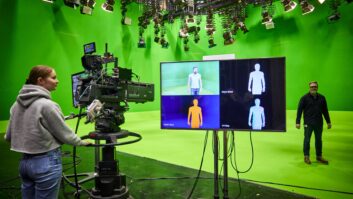The past couple of years has seen an explosion of interest in virtual production. Thanks to projects such as The Mandalorian and The Batman, more and more producers of content ranging from commercials to feature films are looking at using the new technology.
In the UK and Europe, this increase in interest is also driving the development of new studio facilities. Among the companies looking to open their own Volume stage in London is Pixomondo, which already has virtual production stages in both Toronto, used by Star Trek: Discovery, and Vancouver in Canada.
Last year Pixomondo brought Alex Webster on board to oversee its new London operation. As well as working on the virtual stage, the London team has recently added previs to its list of creative services.
“Since we launched we’ve kind of been running three streams in parallel,” Webster tells TVBEurope. “One of which is the traditional pre-production stuff, so Maya-based previs and techvis, and that allows us to visualise and plan those kinds of projects.
“At the same time, we’re developing a similar pipeline toolset using Unreal Engine to be able to really blend the agile virtual production tools such as virtual scouting, virtual camera, motion capture, performance capture photogrammetry all into a previs pipeline so that we can make that process interactive, and leverage everything which is great about Unreal 5. Our third stream is the planning, building, implementation and then operation of our first LED Volume, which mirrors what has been established as the foundation of our model in Toronto and Vancouver where we’ve got three volumes, and my remit is to set up our first one in London.”
Having joined the company as the sole London staff member, Webster has now grown the company to 15 with a core team of supervisors, lead artists, pipeline TDs, IT administrators etc, that he says represent the very best of the London industry. “I’ve been able to pull together this fantastic team spearheaded by Matt Perrin, who is a very experienced previs supervisor who I’ve worked with previously at Framestore, and he comes with decade’s worth of experience working with Marvel and Disney.

“There’s a very thin but highly skilled group of practitioners in London who are exceptional at what they do, and then there’s quite a vacuum underneath that,” he continues. “We’ve been fortunate in that we’ve been able to recruit some very skilled, talented people with credible experience of having worked in virtual production on meaningful projects and are adept when it comes to working in Unreal Engine specifically. What we’re seeing as well is there’s a huge level of interest from the next generation of young artists coming through, who are motivated and want to get into virtual production. They’re learning Unreal because it’s so democratic, and there isn’t a barrier to entry. It’s free software, which is extraordinary, really.”
Webster says he was determined not to launch the new previs services until the London team had a robust enough toolset and pipeline to be able to meet clients’ expectations. “Over the last four or five months or so our supervisors have been working with our pipeline team to develop a toolset which we have proven over that time,” he explains. “They’ve been taking dummy projects and running them through a process to see where the pain points are and make sure that it can deliver.
“We’ve got this rare opportunity where we are starting something essentially from scratch at a point where technology is evolving at a pace unlike anything before, with new iterations of Unreal Engine being released every year. It’s allowing us to take almost an umbrella look at the way that the industry is headed, the importance and the role of game engine technology in the filmmaking process, and to design a pipeline toolset which is really future focused and really pushing the interactive elements of that.”
While the interest in virtual production continues to grow, Webster warns there’s still a relatively small uptake for the technology because “there’s a fear factor involved and still something of a resistance,” he says. “Unless it’s foundational in your thinking as to how you’re going to approach a project and you’re kind of building your schedule and methodology and crew around how to best leverage virtual production, what you often find is that the conversation starts too late in the production process, so a show will be up and running and in pre-production and they’ll have just to brought a visual VFX supervisor on board and at that point production might want to start looking at a Volume shoot for a couple of sequences, which really comes too late in the in the process.
Instead, Webster believes virtual production should be considered at a production’s inception so that the virtual production team can work alongside production design and the camera unit right from the outset, which leads to something “incredibly powerful,” he states.
“From my own experience, having being on set and seeing the the qualitative aspects of virtual production, for actors to be able to shoot in context of an environment, for a director to be able to see the actors in context of the background and not against a green screen and for an editor much earlier in the process to be able to put shots together, adds a huge amount to the filmmaking process.
“The thing that really attracted me to Pixomondo is the absolute firm belief that this is a critical part of the future production process and it does represent a paradigm shift in how high-end TV and features are made,” he says.
Webster adds that he believes technology and creativity go hand in glove. “The technology aspect is a creative endeavour in its own right,” he says. “You’ve got guys developing code and software but they can’t make magic happen and they’re only informed by working closely with our artists and our clients.”







